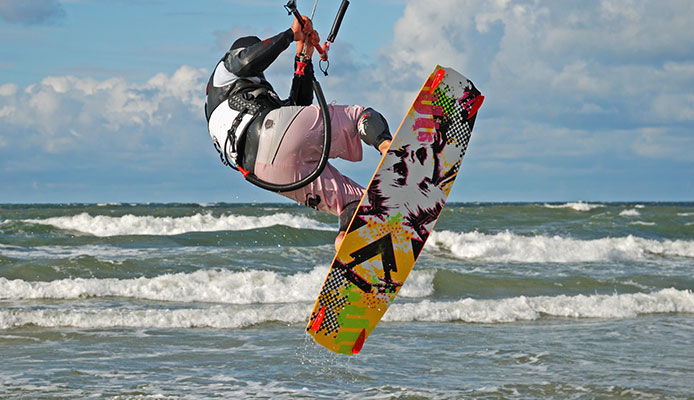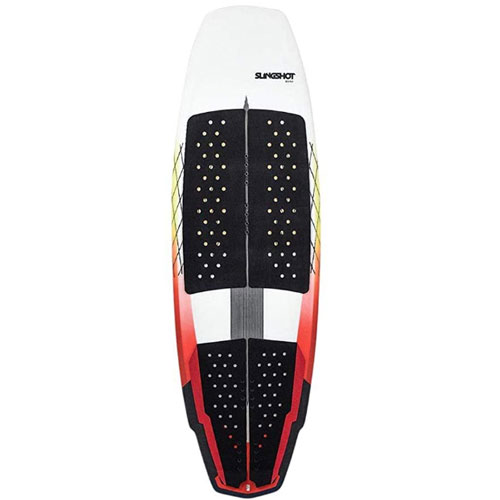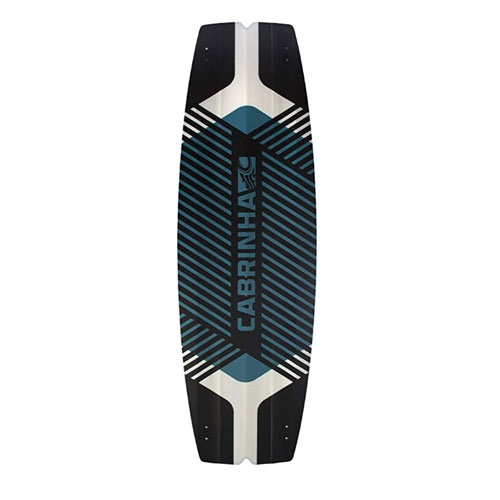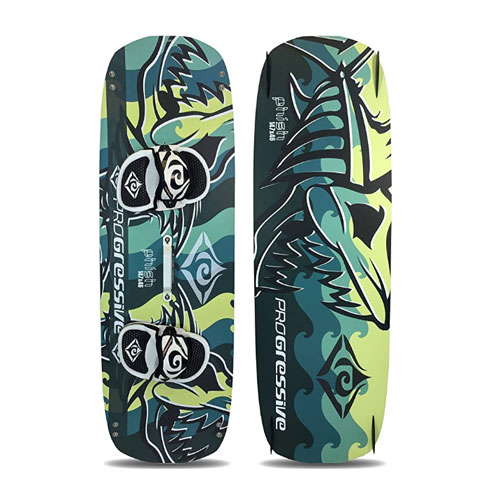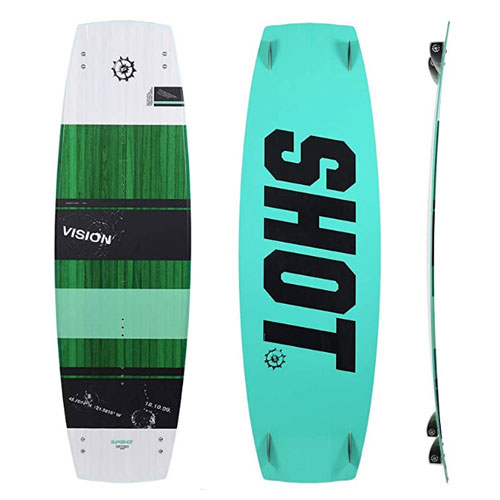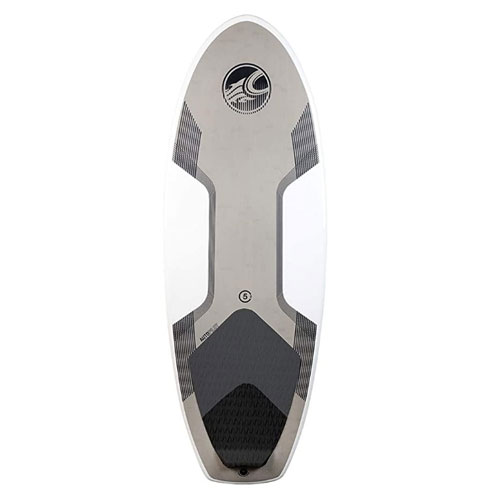To enjoy kiteboard surfing to the maximum, you want to invest in the best kiteboard. Kiteboarding boasts a combination of windsurfing, boarding, and paragliding to give you an extreme watersport experience. Therefore, to match this adrenaline yielding performance, you want to be equipped with a good quality kiteboard.
Kiteboards are designed to offer faster speed and better edging to smoothly glide through the water. Thanks to their pronounced rocker shape, kiteboards offer safer riding with reduced chances of dangerous wipeouts. Additionally, thanks to their shape, kiteboards offer great planing; allowing you to harness as much power and speed to cut through the wind.
You can find a wide selection of kiteboards in the market today. However, we’ve made this work easier for you by compiling the top picks for the 5 best kitesurfing boards for this year. Take your pick of the best option so you can enjoy the water with more adventure.
OUR TOP PICK
Slingshot Sports 2020 SCI-Fly Kiteboard
- What Makes This Kiteboard Stand Out
- Best for aerial, freestyling, and powered up freeriding
- Corduroy deck pad for a softer surface and increased grip
- Top and bottom carbon fiber reinforcements for extra strength and stiffness
- Carbon rails on the tail prevent cracking, heel dents, and damage from hard landings
- Foot strap insert position at the tail for optimal rear foot position for better drive, turn and snap
- FCSI keyless fins for easy set up, storage, and transportation
Material: EPS foam with bamboo and carbon details
Length: 4.8-inch
Width: 17.4-inch
EDITORS CHOICE
Cabrinha 2020 X Caliber Wood Twin Tip Kiteboard
- What Makes This Kiteboard Stand Out
- Best for freestyle, freeride, and wake style
- Double concave center for smoother landings
- Quad channels on the tips for added grip when loading off your back foot
- Wooden construction absorbs chops better for a softer ride and easy edging during tough riding
- Low spin weight for a better riding experience
- ABS rail channels on the rails enhance grip during high speed rides and jumps
Material: Palownia wood
Length: 52-inch/53-inch/54-inch/55.5-inch
Width: 15.7-inch/16-inch/16.5-inch/16.9-inch
BEST VALUE
Progressive Boards Phish Freeride Kiteboard
- What Makes This Kiteboard Stand Out
- Best for all kiteboarding styles and conditions
- Ultralight and stiff body build
- Stainless steel foot inserts for better riding performance and durability
- Aggressive rocker line for better pop and a smoother ride
- 8mm concave bottom for smoother riding
- ABS side rails maintain your stability and enhance your grip
Material: Palownia wood
Length: 57.6-inch
Width: 18.1-inch
Slingshot Sports 2020 Vision Twin Tip Kiteboard
- What Makes This Kiteboard Stand Out
- Best for aggressive freeride crossovers
- Singleshot fusion sidewalls for better dampening and increased durability
- Advanced Naca Vortex Tunnels technology for faster riding
- Increased edge control as well as pop and hold for learning new aerial maneuvers
- Ideally shaped for all levels of high performance freerides
- Pulled tip and tail outline for increased efficiency on the water
Material: Palownia wood
Length: 1.75-inch
Width: 4-inch
- What Makes This Kiteboard Stand Out
- Best for kite foiling and foil surfing
- Beveled rails for increased lean angle
- Rear EVA pad with tail kick enhances traction and control
- Concave deck build for better control
- EPS core for increased strength, stiffness, and reduced weight
- Durable bamboo sandwich construction
Material: Bamboo and EPS
Length: 5.2-inch/5.6-inch
Width: 21-inch/21.4-inch
How To Choose A Kiteboard – Buying Guide
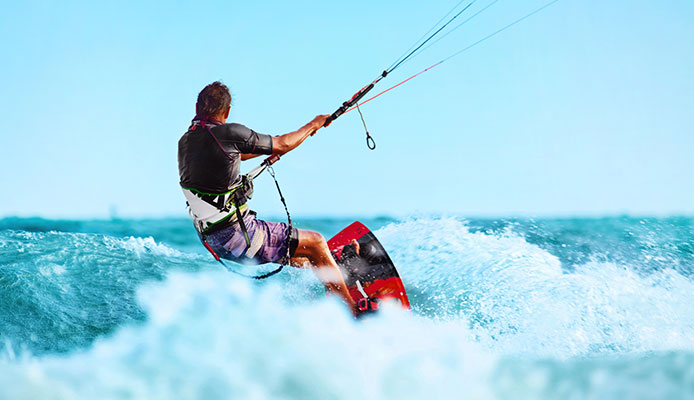
Type
When choosing the best kiteboard, you will have to pick amongst the two commonly available types, i.e. twin tip and all-round/freeride. As a beginner, the best kitesurfing board type is the twin tip. This rectangular, typically symmetrical board features a standard design – fitted with two small fins at each end, foot straps, footpads, and a grab handle in the middle.
When riding, your feet are secured by the foot straps; allowing you to ride the board from either side – left or right. Alternatively, you can use fixed boots in place of foot straps – although this may be somewhat difficult for beginners who are still trying to get accustomed to the water. If you want to travel and storage to be easier, opt for twin tips that allow you to remove the grab handles and fins.
Freeride and all-round kiteboards are a better option for at least intermediate riders. The boards feature a balanced length and width ratio for better control whilst their slight round tips reduce splash. Additionally, they offer great cruising and turning for maximum maneuverability whilst preventing wipeouts too.
Size
The size represents the length and width of your kiteboard. Kitesurfing board widths range between 15 to 17 inches. The kiteboard width determines the amount of water you can displace. A wider kiteboard allows you to turn with ease without using too much effort. Additionally, wider kiteboards are easier to balance even in light wind conditions.
Narrower kiteboards on the other end require more skill and energy to use. Therefore, as a beginner check out wider kiteboard sales to make riding easier. Yet, you must remember that when it comes to maneuverability, you will struggle a bit with wide kiteboards.
You must consider your height and weight when choosing the length. For example, the best kitesurfing board for tall and heavy people is long. If you weigh between 150 and 200 lbs., your ideal kiteboard will measure between 57 and 63 inches. If you weigh below 150 lbs., the ideal length for your kiteboard should be between 53 and 58 inches. If you weigh above 200lbs, the ideal length will be between 59 and 64 inches.
Profile
The profile of your kiteboard represents the general outline. This is when you look at the shape of the board from above. There are two common types of profiles, i.e. square and tapered profiles. A square profile is easier to ride on and offers an upwind drive. Thanks to this design, the square profile is a better option as it facilitates early planing and keeps the board going in a straight line.
However, with a square profile, you will feel more chop. A tapered profile on the other end is perfect for choppy waters and riding at high speed. This design reduces fatigue on your legs as well whilst facilitating a smoother riding experience.
Sometimes, you may find slight asymmetrical boards with a straight back edge (heel side)and a more curved front edge(toe side). These types of boards are perfect for edging with your toes forward. The front edge aids in toe side riding where you flip the board around so you can lean forward with the kite still behind you.
Shape
The shape of your kiteboard can be described from three angles, i.e. from the top (profile), from the side (rocker), and the bottom. Typically, the best kiteboards are flat, channeled, or concave shaped at the bottom.
A flat bottom helps with early planing whilst the channeled bottom helps with speed and keeping the board going forward in strong winds. A concave bottom facilitates riding with speed across the water and when jumping. If you are a beginner, a flat bottomed kiteboard is the best option.
Rocker
The rocker is the kiteboard’s shape viewed from the side – the curving between the board center and the tips. Similar to a flat bottom, a flat rocker helps with early planing and provides easy riding in lighter winds. Additionally, this rocker shape allows you to ride upwind – so you can easily return to the starting point. Curved rocker boards offer better riding in choppy and wave conditions.
Flex
Flex determines the feel of your kiteboard and how it feels underfoot during rides. Longitudinal flex determines the extent to which the board can bend lengthwise from tip to tip whilst torsional flex determines the amount it can twist between the toe and heel side. A soft/high longitudinal flex means the board is soft in the flex; allowing it to absorb more chop for a smoother ride with less stress on the knees.
Medium longitudinal flex offers excellent pop whilst still being smooth through the chop – making it great for freeride and freestyle kiteboards for intermediate riders. A stiff to low longitudinal flex offers a high energy return which allows them to pop better than softer flex. However, they can cause stress to the knees in choppy conditions.
When it comes to torsional flex, a board with too much of it will be dull and unresponsive. Balanced torsional flex keeps your heel side edge contact with water for better upwind performance. Additionally, it offers better landings.
In today’s market, you will find kiteboards designed with a dynamic flex. This design features great flex towards the tips and the middle to offer a balance between the jumping ability and comfort in chop, waves, and landing.
FAQs
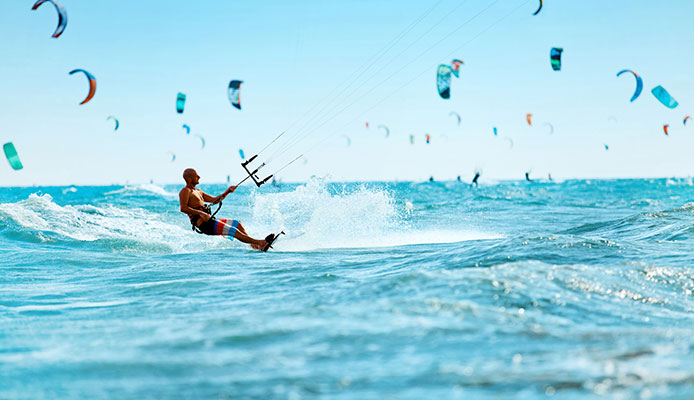
Q: What Are The Best Kiteboarding Brands?
Some of the best brands for kiteboards are Cabrinha kites, Slingshot Kiteboarding, Liquid Force Kites and North Kites These brands have remained popular in the market and are known to produce a wide range of good quality kitesurfing board.
Q: How Long Does It Take To Learn Kiteboarding?
Learning to kiteboard doesn’t take days – you only need 6 to 12 hours to learn how to kiteboard. Compared to other water and wind sports, the learning curve for kiteboarding is quite easy and fast. Within a year, you can become an advanced kiteboard surfer if you are consistent. However, it is somewhat difficult to learn than wakeboarding due to its technicalities.
Globo Surf Overview
Kiteboard surfing can be quite a fun and easy-to-learn water sport compared to sports such as windsurfing. You won’t just enjoy the water and the wind but also sneak in a workout. In these kiteboard reviews, you will definitely find the best kiteboards from the best brands. So, it’s all up to you to pick your favorite option so you can enjoy the waters even more.


